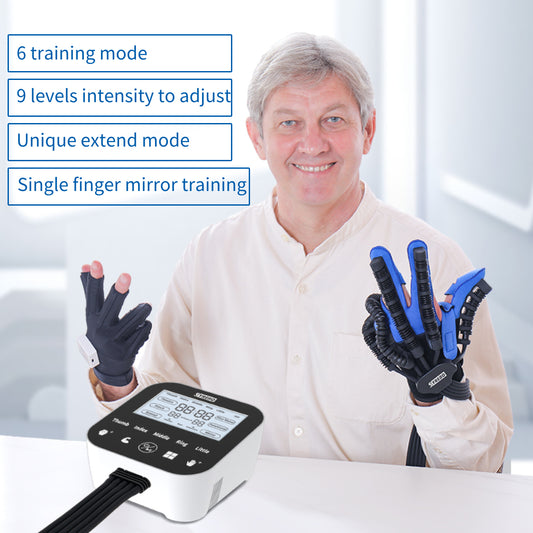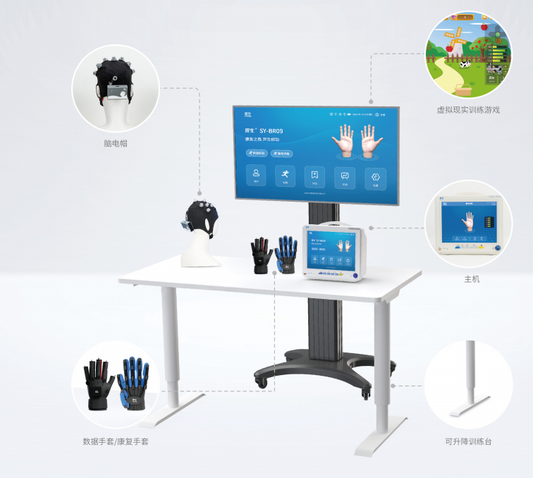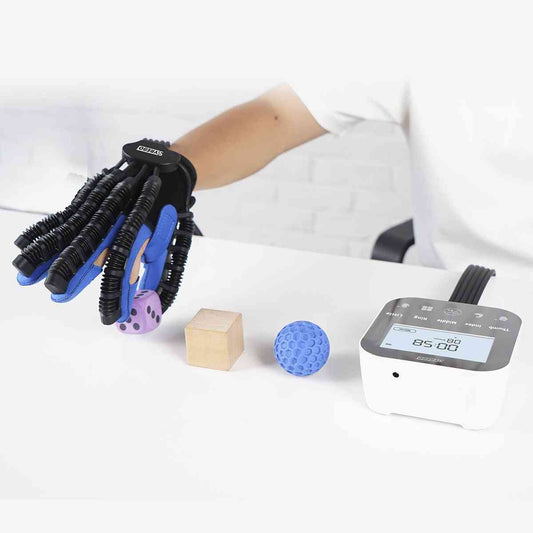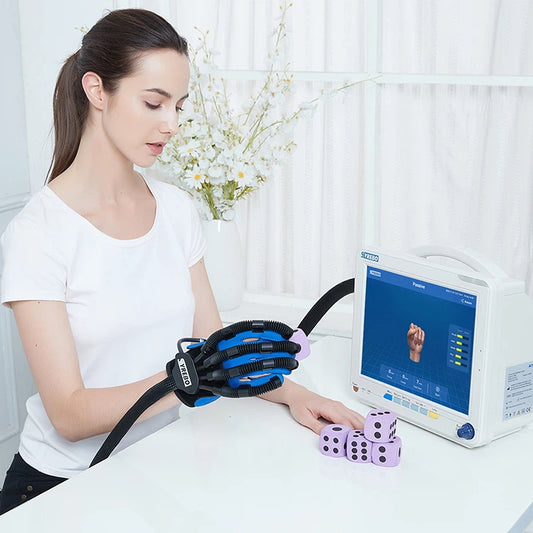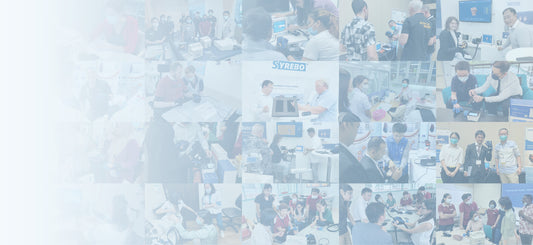Les gants robotisés de rééducation en cas d'AVC sont-ils efficaces ?
Abstrait
Les mains jouent un rôle important dans les activités quotidiennes des personnes. Cependant, un accident vasculaire cérébral, une lésion incomplète de la moelle épinière, une lésion du plexus brachial, la maladie de Parkinson ou une dystrophie musculaire peuvent entraîner une altération de la main, ce qui entraînera la perte de la fonction de la main. Les accidents de la route ou les accidents du travail peuvent également entraîner une altération de la main. Une solution pratique pour les patients serait des exercices de rééducation, alors que le manque d'appareils de rééducation et de traitement de conseil individuel fourni par les médecins ne peut généralement pas garantir l'intensité de l'entraînement pour les patients. Au cours des dernières décennies, les progrès de la robotique ont permis à ces derniers de jouer un rôle important dans le processus de rééducation .
Jusqu'à présent, les gants de rééducation robotisés sont au centre de la recherche : les gants d'assistance souples. Les gants de rééducation souples portables sont fabriqués à partir de matériaux souples, principalement entraînés par un câble, un matériau intelligent ou un actionneur élastomère pneumatique/hydraulique, ce qui permet une structure souple sans articulation pour que la main soit confortable et beaucoup plus sûre. Avec de nombreux avantages tels que leur poids léger, leur nature portable, leur rapport puissance/poids élevé, leur faible coût et leur excellente interaction homme-machine, les gants souples portables devraient être plus adaptés et plus prometteurs pour l'entraînement à la rééducation de la main que leurs homologues rigides. Les gants de rééducation souples peuvent apporter certains effets positifs et améliorer le traitement de rééducation de la main du patient, réduire la charge économique des patients et permettre au patient de réintégrer la société et sa famille le plus rapidement possible.
De nombreuses personnes atteintes de paralysie de la main qui conservent la fonction motrice du poignet peuvent générer un type de préhension passive appelée préhension ténodèse. Cette préhension passive repose sur la faible élasticité des fibres musculaires de la main et des éléments de tissu conjonctif composant l'unité muscle-tendon-os. La préhension ténodèse fonctionne en contractant les muscles extenseurs du poignet et de l'avant-bras par extension du poignet. Cette action tire les tendons des doigts vers le poignet, forçant un moment de flexion, qui peut être utilisé pour produire une posture de préhension dans la main paralysée. Les forces passives produites par une préhension ténodèse sont faibles et généralement suffisantes uniquement pour soulever des objets légers lorsque l'avant-bras est en supination et que la gravité l'assiste. Une préhension active serait donc bénéfique pour les patients en convalescence après un AVC et une lésion de la moelle épinière ( LME ) en leur permettant de soulever des objets plus lourds et de les manipuler dans l'espace libre.
Mots clés : exosquelette, thérapie de la main, neurorééducation, gant robotique souple, technologie
Gant robotisé Syrebo pour les patients victimes d'accident vasculaire cérébral convient aux patients souffrant de dysfonctionnement de la main tel qu'un accident vasculaire cérébral, une hémiplégie après un infarctus cérébral, une lésion du nerf périphérique de la main, une chirurgie orthopédique, une lésion de la moelle épinière, une brûlure de la main, une paralysie cérébrale chez l'enfant, etc.
Associé à la technologie robotique flexible et aux neurosciences, le gant Syrebo peut aider les patients à maîtriser la flexion et l'extension des doigts, réduire la tension musculaire de la main, soulager l'œdème et la raideur, favoriser la rééducation des lésions nerveuses cérébrales par l'exercice, améliorer l'activité de la main et accélérer la rééducation de la fonction de la main.
Introduction
La robotique est actuellement proposée comme une solution non invasive pour améliorer la fonctionnalité de la main au moyen de plates-formes portables et actionnées, à savoir des exosquelettes robotiques, qui sont capables de déplacer les mains des utilisateurs handicapés et d'aider à la fonctionnalité. Un certain nombre d'exosquelettes robotiques pour le membre supérieur distal ont été conçus au cours des dernières années, qui peuvent être classés en fonction de leurs principes d'actionnement, des matériaux utilisés, de la complexité et des fonctions intégrées. Bon nombre de ces dispositifs reposent sur des liaisons rigides, qui nécessitent un alignement minutieux avec les articulations humaines pour transférer de manière sûre et efficace leurs forces et couples robustes et fiables au porteur. Les exosquelettes rigides sont bien adaptés aux scénarios cliniques difficiles, par exemple la rééducation du poignet, de la main et des doigts individuels (pour des revues exhaustives, voir ), mais le compromis de conception pour les forces élevées qui caractérisent ces conceptions mécaniques rigides est leur portabilité limitée en raison du poids des actionneurs électromécaniques et de leurs cadres rigides. Par conséquent, la plupart des systèmes de formation existants sont stationnaires, conçus pour une utilisation en clinique et nécessitent un personnel expérimenté pour surveiller la sécurité et le bien-être du patient pendant l'utilisation.
Les dispositifs souples, légers et mobiles conçus pour une utilisation à domicile offrent un nouveau paradigme d'appareils d'assistance. Les transmissions par câble permettent de réduire le poids et d'augmenter la conformité des systèmes robotiques portables. Cette approche soulage les extrémités distales des unités d'actionnement et de l'électronique lourdes en les déplaçant vers des emplacements plus pratiques, en conservant des cadres rigides ou en les remplaçant par des structures à base de polymère ou de tissu, augmentant ainsi la portabilité, le confort et la facilité d'utilisation des appareils. Bien que les systèmes à câble aient été développés pour améliorer la facilité d'utilisation, réduire le poids et maximiser la conformité, le compromis inévitable est une résistance et une précision réduites par rapport aux exosquelettes rigides traditionnels. Un nombre limité de groupes de recherche ont démontré avec succès que des robots portables à câble assistaient la fonction de la main chez les survivants de lésions de la moelle épinière et d'accidents vasculaires cérébraux . De plus, des gants de rééducation souples robotisés ont été utilisés à la place de la physiothérapie traditionnelle. Ces efforts récents offrent le potentiel de dispositifs sûrs, confortables, légers et rentables qui peuvent fournir aux utilisateurs une assistance à domicile ou des activités de rééducation pendant des périodes prolongées.
Méthode
Comparaison entre thérapie traditionnelle et thérapie robotique douce
En fait, la rééducation traditionnelle et ennuyeuse ne parvient souvent pas à produire des effets de rééducation idéaux. Elle a déjà porté un coup psychologique énorme aux patients, et de nombreux patients ont même abandonné volontairement la rééducation. En réponse à ce problème, nous avons transformé les résultats de la recherche scientifique avancée, coopéré avec des entreprises de l'industrie, du milieu universitaire et de la recherche et développé des gants robotisés de rééducation souples. Il s'agit d'un appareil intelligent pour la rééducation des fonctions motrices de la main chez les patients victimes d'AVC. Il possède de multiples fonctions telles que la rééducation maître-esclave, la rééducation passive, les jeux de réalité virtuelle et l'évaluation de la rééducation. Contrairement aux méthodes de traitement traditionnelles qui nécessitent l'aide de physiothérapeutes, les patients peuvent effectuer l'ensemble du processus de rééducation de manière autonome grâce à des gants robotisés de rééducation souples, ce qui rend la rééducation plus pratique et réduit considérablement le coût de la rééducation.
Parmi les nombreuses thérapies de rééducation traditionnelles, la « thérapie par le miroir » est une méthode très efficace. En général, lors de la thérapie de rééducation par le miroir, on demande aux patients de placer leur main affectée derrière un miroir pour la bloquer. La main saine bouge devant le miroir. Lorsque le patient se regarde dans le miroir, il aura l'impression que sa main affectée fait les mêmes mouvements que la main saine en même temps. L'un de ses principaux mécanismes de rééducation est que l'observation des mouvements forme un retour visuel, active le cortex moteur et favorise la récupération de la plasticité du cortex cérébral.
La « fausse image » dans le miroir peut-elle être transformée en « vraie image » dans la réalité ? À partir de ce point, l'équipe de R&D a combiné le « contrôle maître-esclave », une technologie relativement mature dans le domaine de la robotique, pour créer un prototype de gants robotisés de rééducation souples. Une solution d'exosquelette de main portable maître-esclave est proposée pour permettre aux patients de suivre seuls la formation de rééducation au miroir.
Il est entendu que cette solution permet à la main saine d'un patient hémiplégique de porter un dispositif de collecte d'informations de mouvement comme « main maîtresse », et à la main paralysée de porter un exosquelette robotisé comme « main passive », de sorte que la main maîtresse puisse contrôler la main esclave pour compléter l'entraînement de rééducation par le miroir. Par rapport à la thérapie par le miroir traditionnelle, les patients observent le mouvement de rééducation réel de la main affectée au lieu de l'« image artificielle » dans le miroir. Ce type de rétroaction visuelle devrait stimuler le cortex cérébral de manière plus significative et plus efficace. De plus, le mouvement réel de la main affectée entraîné par l'exosquelette améliorera encore l'effet de rééducation.
L'exosquelette rigide traditionnel présente l'inconvénient d'être volumineux et lourd, et comme le matériau du corps est en métal « froid », l'interface physique homme-machine est peu conviviale et inconfortable à porter. Considérant que tout en garantissant la fonctionnalité de l'exosquelette, il peut également apporter des soins plus humains aux patients. Avec l'émergence récente de la technologie des « robots souples », une paire de gants de rééducation « chauds » pourrait être en mesure de résoudre l'inconfort pendant le processus de rééducation.
Contrairement aux exosquelettes rigides traditionnels, le corps principal des gants de robot de rééducation souples est fait de tissu fabriqué à partir de matériaux de gants courants. Les gants de l'extrémité active sont équipés de capteurs flexibles qui peuvent collecter des informations sur le mouvement des doigts, ce qui équivaut à des gants de données ; les gants de l'extrémité esclave utilisent une méthode d'entraînement linéaire pour imiter la méthode d'entraînement des muscles humains. Lorsque vous portez un dispositif à gants souples, c'est comme si vous mettiez des vêtements. Le capteur du gant actif peut capturer avec précision le mouvement de chaque doigt du côté sain du patient. Combiné à la transmission de données sans fil, l'hôte contrôle ensuite le gant esclave pour aider la main affectée à effectuer le même mouvement.
Conclusion
Les gants robotisés de rééducation feront l'objet de recherches et de développements supplémentaires à l'avenir et intégreront un système de stimulation électrique pour réaliser des fonctions de perception électrotactile et de rétroaction, rendant l'ensemble du processus de rééducation plus conforme aux mécanismes physiologiques humains et formant une boucle fermée entre la perception ascendante et le mouvement descendant, ce qui devrait être plus efficace pour favoriser la récupération de la neuroplasticité et améliorer l'effet de récupération.


